

 |
Search the Site with

|
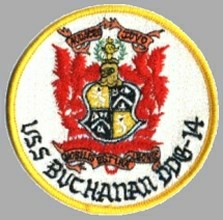 | 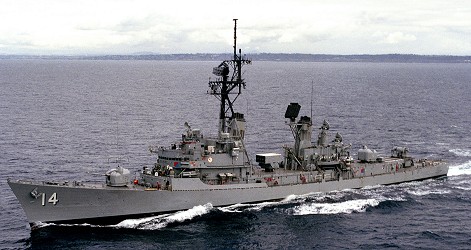 |
USS BUCHANAN was the 13th ship in the CHARLES F. ADAMS - class of guided missile destroyers and the third ship in the Navy to bear the name. Last homeported in San Diego, Ca., the BUCHANAN was stricken from the Navy list on November 20, 1992, and sunk as a target during RIMPAC 2000.
| General Characteristics: | Keel laid: April 23, 1959 |
| Launched: May 11, 1960 | |
| Commissioned: February 7, 1962 | |
| Decommissioned: October 1, 1991 | |
| Builder: Todd Pacific Shipyards Corporation of Seattle, Seattle, Wash. | |
| Propulsion system:4 - 1200 psi boilers; 2 geared turbines | |
| Propellers: two | |
| Length: 437 feet (133.2 meters) | |
| Beam: 47 feet (14.3 meters) | |
| Draft: 20 feet (6.1 meters) | |
| Displacement: approx. 4,500 tons | |
| Speed: 31+ knots | |
| Aircraft:none | |
| Armament: two Mk 42 5-inch/54 caliber guns, | |
| Crew: 24 officers and 330 enlisted |
Crew List:
This section contains the names of sailors who served aboard USS BUCHANAN. It is no official listing but contains the names of sailors who submitted their information.
USS BUCHANAN Cruise Books:
About the Ship's Name:
Franklin Buchanan - born at “Auchentorlie,” in Baltimore, Md., on 17 September 1800 - was appointed a midshipman in the Navy on 28 January 1815 and initially served in the frigate JAVA under Capt. Oliver Hazard Perry. After tours of duty in a succession of ships, mostly in the Mediterranean, Buchanan obtained permission from the Navy Department to enter the merchant service and worked for five years as a mate in a merchantman on a voyage to China. Following that interval, Buchanan returned to the Navy and spent the next six years in a series of ships engaged in the suppression of piracy in the West Indies. Having been appointed a lieutenant on 13 January 1825, Buchanan delivered the frigate BALTIMORE to the Emperor of Brazil the following July.
Following another Mediterranean cruise in the frigate CONSTELLATION, he then served as first lieutenant in the ship-of-the-line DELAWARE, which bore the United States minister to France, Edward Livingston, to his diplomatic post; and Buchanan was among the officers invited to dine with King Louis Philippe.
Buchanan then went ashore to the Philadelphia Navy Yard to perform duty involving the testing of cannon after which service he commanded the receiving ship at BALTIMORE. He joined the frigate CONSTITUTION in April 1839 and sailed for the Pacific where he later served on board the sloop FALMOUTH. Buchanan returned home to the United States in June 1840. Promoted to the rank of commander on 8 September 1841, he received command of the steam frigate MISSISSIPPI. Shortly thereafter, however, he was transferred to command of the sloop VINCENNES in which he spent almost two years hunting slave traders and pirates.
Secretary of the Navy George Bancroft had ordered Buchanan to submit a plan for organizing a new naval school at Annapolis, and on 14 August 1845, he was appointed the first superintendent of what would become the United States Naval Academy. He occupied that post from the school's formal opening on 10 October 1845 until 2 March 1847. In establishing the academy's high standards of discipline and efficiency, Buchanan earned Bancroft's praise for his "precision and sound judgment," and his "wise adaptation of simple and moderate means to a great end...."
His application for active service in the Mexican War accepted, Buchanan commanded the sloop GERMANTOWN, which, during his time in command, participated in the operations against Tuxpan on 18 April 1847 and at Tabasco on 16 June 1847. After another tour ashore, this time in Baltimore, Buchanan took command of the steam frigate SUSEQUEHANNA, which he commanded when she served as flagship for Commodore Matthew Calbraith Perry's expedition to Japan.
Made a member of the Board of Officers to Promote Efficiency in the Navy on his return from Japan, Buchanan soon thereafter became commandant of the Washington Navy Yard. On 14 September 1855, he received promotion to the rank of captain. He was holding that rank when, under the impression that Maryland would secede from the Union, he submitted his resignation from the Navy on 22 April 1861. Soon convinced that North and South could achieve a reconciliation, however, he wrote the Navy Department asking to withdraw his resignation. Nevertheless, Secretary of the Navy Gideon Welles dismissed Buchanan from the service on 14 May 1861.
Appointed a captain in the Confederate Navy on 5 September 1861, Buchanan served as the Chief of the Bureau of Orders and Detail until 24 February 1862, when he assumed command of the Chesapeake Bay Squadron. Flying his pennant in ironclad CSS VIRGINIA, Buchanan surprised a Union squadron in Hampton Roads on 8 March 1862. VIRGINIA destroyed the frigate CONGRESS, the sloop CUMBERLAND, and three smaller steamers. Late in the action, Capt. Buchanan, enraged at Union troops who violated naval etiquette by firing on his men when they tried to take the surrender of CONGRESS, went topside to return the fire with a Sharps carbine, but a Union sharpshooter’s Minié ball shattered his left thigh. The wound prevented him from exercising command the following day when VIRGINIA met the Union ironclad MONITOR in Hampton Roads.
Commended nonetheless for his "gallant and meritorious conduct," Buchanan was promoted to rear admiral on 26 August 1862. Thus becoming the ranking officer in the Confederate States Navy, he was given command of the South's naval forces at Mobile Bay. Wearing his flag in the ironclad ram TENNESSEE, Rear Admiral Buchanan led a daring single-ship attack against Rear Admiral David Glasgow Farragut's entire squadron in the Battle of Mobile Bay on 5 August 1864 after all his other ships had been either captured or driven off. Damage to his flagship compelled Buchanan, who had again been seriously wounded, to surrender. He remained a prisoner of war until exchanged in February 1865.
Returning to his home in Maryland's Talbot County, "The Rest," after the war, he later became president of the Maryland Agricultural College (later the University of Maryland) in September 1868. He remained in that post until June 1869, after which time he served as secretary of the Alabama branch of the Life Insurance Company of America. After about a year in that line of work, he once again returned to "The Rest," where he ultimately died on 11 May 1874.
RIMPAC 2000 - BUCHANAN's final days:
USS BUCHANAN was one of four decommissioned ships that were sunk as targets during RIMPAC 2000. The other three ships were the BELKNAP-class cruiser WORDEN (CG 18), the guided missile frigate RAMSEY (FFG 2) and the USS GENERAL HUGH J. GAFFEY (AP 121).
The sinking of the ships was conducted at the Pacific Missile Range Facility, north of the Hawaiian Island of Kauai, and focused on honing weapons firing skills and proficiency.
Missile firing and torpedo firing exercises to sink the BUCHANAN started June 13. Three Hellfire hits, three Harpoon hits and a 2,400 pound laser-guided bomb hit were not enough to sink the ship. The job was finally done by 200 pounds of explosive charges set by an EOD team so that the BUCHANAN sunk on June 14, 2000.
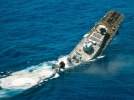 | 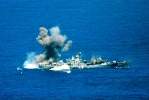 | 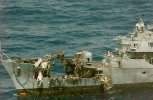 | 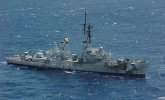 | 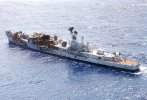 |
USS BUCHANAN Image Gallery
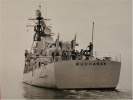 | 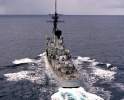 | 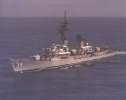 | 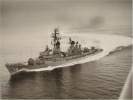 | 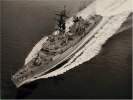 |
 | 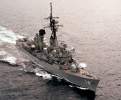 |
 Back to Destroyer list.
Back to Destroyer list.  Back to ships list.
Back to ships list.  Back to selection page.
Back to selection page.  Back to 1st page.
Back to 1st page.